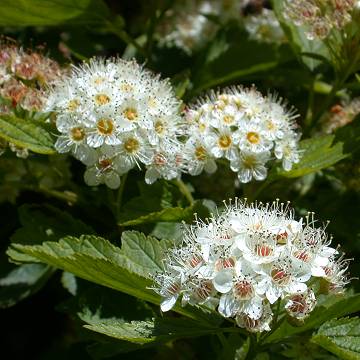

Physocarpus opulifolius - (image 1 of 7)
Taxonomy
Family: Rosaceae
Habitat
Dry rocky slopes, calcareous moist habitats. Moist swale borders. Highly adaptable.
Associates
On rocky slopes with Celastrus scandens, Parthenocissus quinquefolia, Prunus virginiana, Ptelea trifoliata, Rhus glabra, Vitis riparia. In calcareous moist habitats with Angelica atropurpurea, Cirsium muticum, Cornus obliqua, Equisetum arvense, Rudbeckia laciniata, Senecio aureus, Solidago patula.
Distribution
Quebec west to MI and MN, south to VA, TN.
Morphology
Deciduous shrub to 10" high and wide. Leaves alternate, simple, to 3" long, 3-5 lobed; lobes acute, crenate-dentate. Stems shiny red-brown when young, exfoliating in papery strips when older. Flowers white to pink, in dense 2" diameter corymbs; petals 5; stamens about 30. Fruit a follicle.
Notes
Flowers late May to mid June
Wetland indicator: Facultative Wetland -
An occasionally planted shrub that is uncommon in the wild. The purple-leaved cultivar in some of these pictures is P. opulifolius 'Diablo'. Dirr does not seem to think highly of this species, probably because of its uneven growth. Requires pruning to maintain a symmetrical shape and even then may be best suited for massing or borders.
References
Dirr, Michael A. 1998. Manual of Woody Landscape Plants:
Their Identification, Ornamental Characteristics, Culture, Propagation and Uses.
5th ed. Champaign, Illinois: Stipes Publishing L.L.C..
Swink, F. and G. Wilhelm. 1994. Plants of the Chicago Region.
Indiana Academy of Science. The Morton Arboretum. Lisle, Illinois.
|
Michael Hough © 2005 |